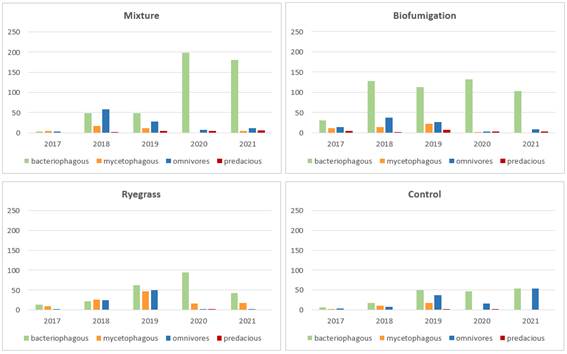INTRODUCTION
The intensification of crop production frequently leads to soil imbalances, both in terms of physical properties and the biodiversity it harbors, with repercussions on plant health and yielding. This is the case of the intensive horticultural production systems in Ribatejo (central Portugal), mostly dedicated to the monoculture of tomato and potato, with a high degree of technical interventions.
Nematodes, small animals inhabiting all ecosystems, are often used as soil status bioindicators (Neher, 2001) namely the free-living nematodes (e.g., nematodes that live free in the soil and not parasitizing plants) because:
i) they are numerous in soils; ii) they are easily retrieved from soil samples and sorted by their trophic group (bacteriophagous, mycetophagous, etc.) iii) their numbers reflect the microorganisms on which they feed upon and the balance of the different populations; iv) their numbers fluctuate according to the dynamics of these populations and the physical and chemical soil proprieties.
At the soil nematofauna level, intensive agricultural practices such intensive mobilizations and pesticide applications result in biodiversity disruption and lead to the emergence of serious phytosanitary problems for which there is a growing lack of control methods. Pesticides can act directly on nematodes or on the soil’s microfauna, in both cases causing disturbance of the nematofauna since free living nematodes feed upon bacteria and fungi, naturally controlling these populations.
This work evaluated the community of nematodes in experimental plots, for the period 2017-2021, where different cover crops were installed prior to main crop cultivation: 1) biodiverse mixture of grasses and legumes; 2) annual ryegrass and 3) forage turnip, a biofumigant. In the control plot no cover crop was set. The conclusion was that free-living nematodes increased in all treatments compared with the control plot, in particular the in mixture treatment, indicating an improvement in the organic matter content of plots.
MATERIAL AND METHODS
Three experimental plots and a control were set up in each one of the two selected locations - Golegã (S. João de Brito) and Vila Franca (Manique). Three samples of rhizospheric soil were collected in each of the three plots and the test, where different cover crops were installed prior to main crop cultivation: 1) biodiverse mixture of grasses and legumes, including Trifolium resupinatum inoculated with nitrogen-fixing rhizobia (40kg/ha); 2) Lolium multiflorum (annual ryegrass 35kg/ha), a mycotrophic grass favouring soil enrichment in endemic mycorrhizal fungi; and 3) Raphanus sativus (forage turnip 25kg/ha), a biofumigant species contributing to the suppression of pathogens when incorporated into soil. In the control plot no cover crop was set. Soil samples collected after the experimental period were immediately brought to the nematology lab of INIAV (Campus Oeiras) and processed in the next few days. Extraction of nematodes from these samples was performed using the Baermann funnel technique and the centrifugal flotation method (EPPO, 2013). The different nematode trophic groups were evaluated by morphological observation under a stereomicroscope (Nikon SMZ1500, Tokyo, Japan) followed by light microscope (Olympus BX-51, Hamburg, Germany) observations. Species identification was confirmed by molecular analyses (data not shown).
RESULTS AND DISCUSSION
Results for the two locations were pooled. A high proportion of bacteriophagous was detected in all treatments compared with the control plots. This trend was further observed for the mixture plots (Figure 1).
Omnivorous and predatory nematodes were found less. The reduced number of omnivorous and predatory nematodes confirms the type of farming with cultural intensification (annual crop), in which fallow period is short and probably enough for nematodes populations to recover after imbalance factors (mobilizations, application of pesticides, etc.).
The proportion of the different trophic groups in a soil nematofauna can be converted into relevant information regarding its biological status. The prevalence of bacteriophagous over the other groups indicates a fast nutrient recycling trough decomposition done by bacterial populations. This group of nematodes tends to increase their numbers with the increase of soil organic matter.
In what concerns plant parasitic nematodes, namely Meloidogyne and Globodera species spp., their detection was performed according to Conceição et al. (2009), Rusinque et al. (2022), and Camacho et al. (2020), respectively. The number of parasitic nematodes fluctuated according to the crop cycle and were not considered in this analysis.
CONCLUSION
Nematodes can be used as indicators of soil status because their populations are easily disturbed by bad soil practices. Introducing best soil management practices is expected to have a positive impact on nematodes’ populations, which was observed with the incorporation of biodiverse mixtures into the cultural scheme. The project MaisSolo aimed at demonstrate the advantages of introducing modifications in the current monoculture systems to practices such as the installation of cover crops during the fall-winter period, preceding the main crop in the production year. The results obtained constitute a relevant contribution for the implementation of nature-based solutions alternative to the intensification and overuse of pesticides in Ribatejo producing region















